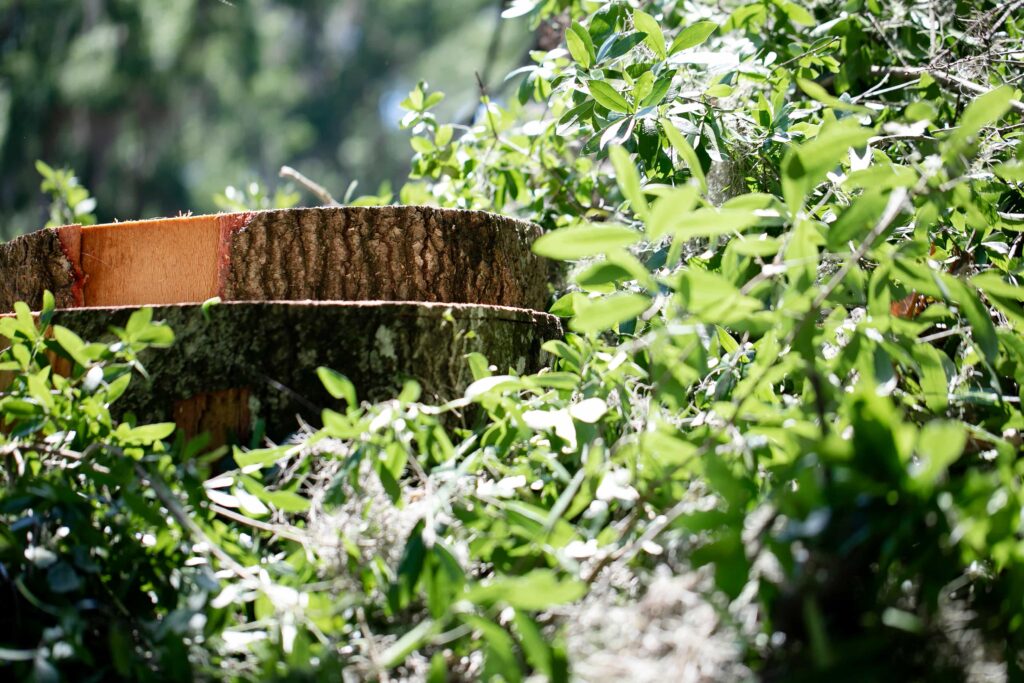After removing a tree from your yard, you will soon notice how much of an eyesore and tripping hazard stumps are. Here, our experts at Gaston’s Tree Service address some of the commonly asked questions about stump removal.
Stump Removal Methods
Many people use the terms stump removal and stump grinding interchangeably. But, there are many stump removal methods, the two most common being through either digging or grinding.
Digging
An excavator is used to dig out the stump. Digging removes most, if not all, of the tree’s roots and works well for eliminating many stumps at one time. However, this method is much more likely to damage the area around the stump and, if the stump’s root system is extensive, the excavator can leave much larger holes in your yard. Digging is also more expensive and is only possible if the stump is away from other structures in your yard.
Grinding
With grinding, a machine is used to pulverize the stump into wood chips, chewing the tree’s trunk and roots anywhere from 6-18 inches deep. After grinding, the stump is turned into wood chips and dirt that can be used as mulch in your yard. Despite how noisy and messy stump grinding can be, it’s often the most preferred method because it’s faster, better to get to difficult-to-reach places, and creates a smaller hole in your yard than digging.

Common Stump Removal FAQs
Will the stump just decompose naturally if I leave it alone?
Eventually, yes. But, older tree stumps can take 20 or more years to decompose, which varies depending on the presence of pests or diseases. The stump will continue to be a visual and physical nuisance in your yard during that time.
Why is stump removal necessary?
Stumps in your yard are unattractive, reduce your home’s curb appeal, and sometimes occupy parts of your landscape you could otherwise use and enjoy. They host pests, snakes, and vermin, and once these species invade and multiply, they can prove quite expensive to remove. Worse still, stumps are dangerous because they – and their root systems – are a tripping hazard, particularly at night.
Can I replant something where my tree stump used to be?
This answer depends on which removal method you use. If the stump has been dug out and all of its root system removed, it’s possible to put something where it used to be in your yard. On the other hand, if the stump has been ground out, there may still be part of the root system underground. The decomposing stump remains can change the soil’s acidity, making it unwise to plant in that same spot.
What equipment is used to grind stumps?
A stump grinder is a machine that allows for the stump to be essentially shaved down until there is nothing left, using a wheel with a spinning carbide tip. As the wheel turns, it gradually moves deeper and deeper down the stump. While effective, this process is loud and can be messy, so Gaston’s Tree Service takes precaution to avoid damaging your nearby property.
How long does it take?
The size and location of the stump determine how long it takes to grind it thoroughly. If your stump is small and in an easily accessible place, it can be done around 15 minutes or so. More massive stumps in harder to reach locations can take hours.
Will I be left with an unsightly hole in my yard?
We will not leave you with an unsightly crevice in your landscape. We use the chips and sawdust created from your stump to fill the stump removal hole. Then, we haul off any excess sawdust and turn it into usable mulch.
Rely on Gaston’s for Your Stump Removal
Removing the stump will increase your property’s aesthetic value, remove tripping hazards from your yard, prevent the tree from growing back in the future, prevent pest infestation, and create more usable space in your landscape. If you’re ready to reclaim your yard or have any questions that this article hasn’t answered, please contact Gaston’s Tree Service. We can provide you with expert advice and a customized stump removal quote, whether you have one to remove or dozens. Gaston’s Tree Service is here to help – contact us today.
